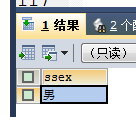sql常用操作(一)
sql(structured query language,结构化查询语言)语言:和数据库交互的语言,进行数据库管理的语言。
1.1 sql语句的作用:说白了就是增删改查
管理数据库
管理表
管理数据
2数据库的操作
2.1创建数据库
create database db_name
[default] character set charset_name -- character set:指定数据库采用的字符集
[default] collate collation_name --collate:指定数据库字符集的比较方式(校对规则)
例:
create database mydb1;
create database java0929 default character set utf8;

2.2查看数据库
1)查询所有数据库
show databases;
2)显示数据库创建语句:
show create database db_name;


2.3修改数据库
alter database db_name
[default] character set charset_name
| [default] collate collation_name
例:alter database mydb2 default character set gbk;

12.4删除数据库
drop database db_name
3表的操作
注意(创建表前,要先使用use db语句使用库)
3.1查看所有表
show tables;
3.2创建表
create table table_name
(
field1 datatype,
field2 datatype,
field3 datatype
)
--field:指定列名 datatype:指定列类型
3.3查看表结构
desc 表名;

3.3数据类型
数据类型:http://www.runoob.com/mysql/mysql-data-types.html
最常用的有四个:
整型: int
浮点型:double(精度更大,常用)
字符:varchar(可变长度,最常用,按实际占用的为准)
日期:datetime(年月日时分秒)
3.4删除表
drop table 表名;
3.5修改表
1)添加字段
alter table 表名add column 字段名 字段类型;
例:alter table order01 add column odesc varchar(50);
2)删除字段alter table 表名 drop column 字段名;
例:alter table order01 drop column money;
3)修改字段类型
alter table 表名 modify column 字段名 字段类型;
例:alter table order01 modify column otime varchar(20);
4)修改字段名称
alter table 表名 change column 原字段 新字段 字段类型;
例:alter table order01 change column otime ordertime varchar(20);
5)修改表名称
alter table 原表名 rename to 新表名;
例:alter table order01 rename to order02;
4 数据的操作
4.1增加数据
插入所有字段。一定依次按顺序插入
insert into 表名 values(值1,值2,值3...);
-- 注意不能少或多字段值
例:insert into order02 values(1,'名称1','2018-11-13','商品描述');
-- 插入部分字段
insert into student(id,name) values(2,'李四');
insert into 表名(字段1,字段2,字段3...) values(值1,值2,值3...);
例:insert into order02(oid,productname,odesc) values (2,'手表','手表的描述');
4.2修改数据
带条件的修改(推荐使用)
update 表名 set字段名=值,字段名=值,....
例:update student set gender='男',age=30 where id=2;
4.3删除数据
4.3.1-- 带条件的删除(推荐使用)
delete from 表名 where条件;
例:delete from student where id=2;
4.3.2两种全表删除的方式:
delete from: 可以全表删除
1)可以带条件删除
2)只能删除表的数据,不能删除表的约束
3)使用delete from删除的数据可以回滚(以后学“事务”时会再学)
-- truncate table: 可以全表删除
1)不能带条件删除
2)即可以删除表的数据,也可以删除表的约束
3)使用truncate table删除的数据不能回滚
truncate table student;
类似一个进回收站,一个直接从硬盘上删了
5查询数据(重点)
以下都是单表查询:
5.1查询所有列
select * from 表名;
5.2查询指定列
select 字段1,字段2,字段3... from student;
例:select id,name,gender from student;
5.3查询时添加常量列(添加别名)
select 字段 as '别名' from 表名;
例:select id,name,gender,age,'java就业班' as '年级' from student;
5.4查询时合并列
select id,name,(servlet+jsp) as '总成绩' from student;
注意:合并列只能合并数值类型的字段
结果图:
5.5查询时去除重复记录
select distinct 字段 from 表名;
-- 另一种语法
select distinct(字段) from 表名;
5.6条件查询
条件查询使用where
1)逻辑条件and(与) or(或)
select * from score where sid=1 and ssex='男';
select * from score where sid=2 or ssex='女';
2)比较条件: > < >= <= = <>(不等于) between and (等价于>= 且 <=)
例:
select * from score where html>60 and js<=80;
select * from score where html>=60 and html<=100;
select * from score where html between 60 and 100;
select * from score where jquery<>66;
3)判空条件(null 空字符串)
null vs 空字符串
-- null:表示没有值
-- 空字符串:有值的,但是值是空字符串
例:
/*判断是否为null*/
select * from score where js is not null;
select * from score where js is null;
/*判断是否为空字符串*/
select * from score where ssex <> '';
select * from score where ssex = '';
4)模糊条件
like
% : 表示任意个字符
_ : 表示一个字符
例:
select * from score where sname like '张%';
select * from score where sname like '__';
select * from score where sname like '%超%';
select * from score where sname like '张__';
5.7聚合查询(使用聚合函数的查询)
常用的聚合函数: sum() avg() max() min() count()
注意:count()函数统计的数量不包含null的数据
-- 使用count统计表的记录数,要使用不包含null值的字段
例:
select sum(js) as 'js总成绩' from score;
select sum(js) as 'js总成绩' from score where ssex='男';
select avg(html) as 'html平均分' from score;
select max(jquery) from score;
select min(js) from score;
select count(*) from score;
5.8分页查询
语法格式:limit 起始行,查询几行
行:一条记录
起始行从0开始
用户只能点页数,所以可以获取到“当前页”,计算起始行:(当前页-1)*每页显示的条数,每页显示的条数可以人为设定。
例:
/*第一页*/
select * from score limit 0,2;
/*第二页*/
select * from score limit 2,2;
/*第三页*/
select * from score limit 4,2;



5.9 查询排序(order by)
语法 :order by 字段 asc/desc
默认情况下,按照插入记录顺序排序
select * from 表名;
-- asc: 顺序,正序。数值:递增,字母:自然顺序(a-z)
-- desc: 倒序,反序。数值:递减,字母:自然反序(z-a)
默认正序,所以asc可以不写
例:
select * from score order by html;

select * from score order by js desc;

先写where,再order by
select * from score where ssex='男' order by js desc;

按两个字段排序:(当第一个字段有相同值时,再按第二个排)
select * from score order by js,jquery desc;

5.10 分组查询(group by)
5.10.1
select 字段1, 字段2 from 表名 group by 字段;
例:
select ssex,count(*) from score group by ssex;

select ssex as '姓别',sum(js) as 'js总分' from score group by ssex;

5.10.2分组查询后筛选
分组之前条件使用where关键字,分组之后条件使用having关键字
having只能和group by一起用
例:
/*查询总人数大于2的性别*/
select ssex from score group by ssex having count(*)>2;

查询总结:
注意顺序:
select [all | distinct] 字段或表达式列表 [from子句] [where子句] [group by子句] [having子句] [order by子句] [limit子句];



